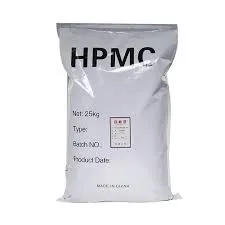
Dec . 04, 2024 22:25 Back to list
hpmc solubility in water
Understanding HPMC Solubility in Water An Overview
Hydroxypropyl methylcellulose (HPMC) is a versatile cellulose ether that has gained significant attention in various industries due to its unique properties. One of the most critical attributes of HPMC is its solubility in water, which affects its application in pharmaceuticals, food processing, cosmetics, and construction materials. This article explores the solubility of HPMC in water, its implications for different industries, and the factors that influence its solubility.
Properties of HPMC
HPMC is synthesized by modifying natural cellulose through the addition of hydroxypropyl and methoxy groups. These modifications enhance the solubility of cellulose, which is inherently insoluble in water. The chemical structure of HPMC consists of hydrophilic hydroxyl groups and hydrophobic methyl groups, allowing it to dissolve in water, forming a viscous solution. This solubility varies based on the degree of substitution and molecular weight of the HPMC used.
Mechanism of Solubility
The solubility of HPMC in water can be attributed to hydrogen bonding interactions between the HPMC molecules and water. When HPMC is introduced to water, the hydrophilic groups interact favorably, disrupting the hydrogen bonds between water molecules and allowing HPMC to disperse. The extent of this interaction is affected by the temperature and concentration of HPMC in the solution. Higher temperatures generally enhance solubility, as they provide energy that helps overcome molecular interactions that would otherwise keep HPMC insoluble.
Applications in Various Industries
1. Pharmaceuticals In the pharmaceutical industry, HPMC is widely used as a binder, thickener, and film-forming agent in tablet formulations. Its solubility plays a vital role in determining the release profile of active ingredients. For instance, HPMC can be used to develop controlled-release formulations, where the polymer’s viscosity and solubility characteristics help regulate drug release rates.
2. Food Industry HPMC is also an excellent stabilizer and thickener in food applications. It enhances the texture and mouthfeel of various products, such as sauces and dressings. Its ability to dissolve in water makes it a preferred choice for gluten-free baking, as it improves dough structure and moisture retention.
hpmc solubility in water

3. Cosmetics In personal care products, HPMC is valued for its thickening and film-forming properties. Its solubility allows for easy incorporation into lotions, creams, and gels, improving product texture and stability. Moreover, due to its non-toxic and biodegradable nature, HPMC is a popular ingredient in natural and organic cosmetics.
4. Construction In the construction industry, HPMC serves as an additive in cement-based products, such as tile adhesives and plaster. Its solubility in water contributes to improved workability and adhesion properties, ensuring better performance of construction materials.
Factors Influencing Solubility
Several factors can influence the solubility of HPMC in water
- Molecular Weight Generally, lower molecular weight HPMC grades dissolve more easily in water compared to higher molecular weight grades. The molecular weight affects the viscosity of the resulting solution, with higher molecular weights leading to thicker solutions.
- Degree of Substitution (DS) The degree of substitution refers to the average number of hydroxyl groups replaced by methoxy and hydroxypropyl groups. Higher DS typically corresponds to increased solubility since more hydrophilic groups are present to interact with water.
- Temperature As previously mentioned, temperature plays a key role in the solubility of HPMC. Increasing the temperature can enhance the dissolution rate and the final solubility of HPMC in water.
Conclusion
The solubility of HPMC in water is a critical attribute that dictates its functionality across various applications. Understanding the factors that influence its solubility allows industries to optimize formulations for desired outcomes. As research and development continue in this area, HPMC's role as an essential additive in pharmaceuticals, food, cosmetics, and construction is likely to expand, driven by its versatility and performance characteristics.
-
Versatile Hpmc Uses in Different Industries
NewsJun.19,2025
-
Redispersible Powder's Role in Enhancing Durability of Construction Products
NewsJun.19,2025
-
Hydroxyethyl Cellulose Applications Driving Green Industrial Processes
NewsJun.19,2025
-
Exploring Different Redispersible Polymer Powder
NewsJun.19,2025
-
Choosing the Right Mortar Bonding Agent
NewsJun.19,2025
-
Applications and Significance of China Hpmc in Modern Industries
NewsJun.19,2025







